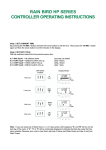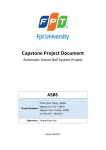Download Implementation of a multithreaded environement for AVR
Transcript
Implementation of a multithreaded environement for
AVR using Nuptse.
Julien TOUS
November 13, 2007
1
introduction
This document describes the architecture and internals of an implementation of a
multithreaded environement for AVR. This implementation only uses standard Kortex components, without customized intervention of the Nutpse compiler (No architctural aspects). For such an implementation have a look at the Buzz aspect at
svn.forge.objectweb.org/svnroot/think/experiments/buzz
Large part of this document, and the code it describes is inspired by : http://www.
avrfreaks.net/modules/FreaksArticles/files/14/Multitasking%20on%20an%20AVR.
pdf which itself is greatly inspired by FreeRTOS AVR port. Both are worth taking a
look at for a general understanding. The avr-libc doc and FAQ http://www.nongnu.
org/avr-libc/user-manual/FAQ.html is also a great source of answer for many avr
related questions. We will here, mainly focus on the kortex implementation.
As the treatment of interruption is by some way related to multithreaded programming
we will also have a look at it and the conveniences given by the avr-libc.
2
2.1
AVR specifique low level code
AVR registers
AVR microcontrollers get 32 general purpose registers (r0 to r31). All those registers
are 8 bit wide, althought some instructions treate X (r26-r27), Y (r28-r29) and Z (r30r31) as 16 bits words. Then SREG register contains interruption related informations,
SP the stack pointer, PC the program counter. The state of all those registers, defines a
context.
While debuging with gdb, you can monitor those registers with the command :
(gdb) info reg
which will output something similar as the following:
r0
0x65
101
’e’
1
r1
r2
r3
r4
r5
r6
r7
r8
r9
r10
r11
r12
r13
r14
r15
r16
r17
r18
r19
r20
r21
r22
r23
r24
r25
r26
r27
r28
r29
r30
r31
SREG
SP
PC
0x0
0x0
0x0
0x0
0x0
0x0
0x0
0x0
0x0
0x0
0x0
0x0
0x0
0x0
0x0
0x0
0x1a
0x14
0x2
0x0
0x6c
0x46
0x6
0x0
0x2e
0x1b
0x2
0x97
0x21
0x4d
0x6
0x80
0x802194
0x6c96
0
’\0’
0
’\0’
0
’\0’
0
’\0’
0
’\0’
0
’\0’
0
’\0’
0
’\0’
0
’\0’
0
’\0’
0
’\0’
0
’\0’
0
’\0’
0
’\0’
0
’\0’
0
’\0’
26
’\032’
20
’\024’
2
’\002’
0
’\0’
108
’l’
70
’F’
6
’\006’
0
’\0’
2
’\002’
27
’\033’
2
’\002’
151
’\227’
33
’!’
77
’M’
6
’\006’
128
’\200’
0x802194
27798
You can also monitor each of them separatly with for example :
(gdb) print /x $r1
$4 = 0xa0
SREG is mapped as a register at 0x3f (it is also mapped in memory at 0x5f). SPL and
SPH (which respectivly contains light weight Byte and heavy weight Byte of SP) are
mapped as registers at 0x3d and 0x3e (they are also mapped in memory at 0x5d and
0x5e).
2
2.2
The trap component.
All context manipulation (Saving, restoring initializing) are handled by the trap component. The trap component itself uses the macros defined in the context.h header.
2.2.1
Switching from a running thread to a suspent one
Assuming a kernel initialize and uses two threads ( thread0 and thread1 ). At a given
instant thread0 is active and ask (we will later see how) to pause it’s execution in
favor of thread1. (table 1) The switchContext method from trap interface of trap
component will be call :
__attribute__ ((naked)) void SRV_trap__switchContext( jbyte* old_context, jbyte* new_c
DEBUG_PRINTF("SRV_trap__switchContext \n");
DEBUG_PRINTF("Saving old_context : %x \n", old_context);
// Make the global variable context
// point on the current stack pointer
// to use it the assembly
// SAVE_CONTEXT macro.
context = old_context;
// Save current context
SAVE_CONTEXT();
// restore the new context only if it exists
if( new_context != 0 ) {
DEBUG_PRINTF("Restoring new_context : %x \n", new_context);
// Make the global variable context
// point on the new stack pointer
// to use it the assembly
// RESTORE_CONTEXT macro.
context = new_context;
// Set the new context
RESTORE_CONTEXT();
}
else {
DEBUG_PRINTF("Trying to load a non existing context ? \n");
}
// naked function. need manual ret
__asm__ __volatile__ ( "ret" );
}
switchContext takes two parameters which should respectively be the pointer to the
(current) thread0 context pointer (old context), and the pointer to the (to be activated)
thread1 context pointer (new context).
3
switchContext uses the naked attribute. This prevent the compiler (don’t know if any
compiler but gcc uses such attributes) from adding data to the stack when jumping to
the switchContext code : Only the Program Counter (3 bytes on an atm2561) will be
added to the stack. ( table 2)
Using DEBUG_PRINTF (if PRINTF is defined) will then add data on the stack (table 3),
and remove it while returning. (table 4) Setting the value of the global variable context
to old_context leaves the stack untouched. We can now execute the assembly code in
the SAVE_CONTEXT() macro :
#define SAVE_CONTEXT()
asm volatile ( \
"push
r0
"in
r0, __SREG__
"cli
"push
r0
"push
r1
"clr
__zero_reg__
"push
r2
"push
r3
"push
r4
"push
r5
"push
r6
"push
r7
"push
r8
"push
r9
"push
r10
"push
r11
"push
r12
"push
r13
"push
r14
"push
r15
"push
r16
"push
r17
"push
r18
"push
r19
"push
r20
"push
r21
"push
r22
"push
r23
"push
r24
"push
r25
"push
r26
\
\n\t"
\n\t"
\n\t"
\n\t"
\n\t"
\n\t"
\n\t"
\n\t"
\n\t"
\n\t"
\n\t"
\n\t"
\n\t"
\n\t"
\n\t"
\n\t"
\n\t"
\n\t"
\n\t"
\n\t"
\n\t"
\n\t"
\n\t"
\n\t"
\n\t"
\n\t"
\n\t"
\n\t"
\n\t"
\n\t"
\n\t"
4
/* Save r0 content on the stack */ \
/* Put SREG content in r0 */ \
/* Disable interruptions */ \
/* Save r0 content (initial SREG value) on the
/* Save r1 content on the stack */\
/* Put 0 in r1*/\
/* Save r2 content on the stack */ \
\
\
\
\
\
\
\
\
\
\
\
\
\
\
\
\
\
\
\
\
\
\
\
\
"push
"push
"push
"push
"push
"lds
"lds
"in
"in
"adiw
"st
"st
);
r27
r28
r29
r30
r31
r26, context
r27, context + 1
r24, __SP_L__
r25, __SP_H__
r24, 0x1
x+, r24
x+, r25
\n\t"
\n\t"
\n\t"
\n\t"
\n\t"
\n\t"
\n\t"
\n\t"
\n\t"
\n\t"
\n\t"
\n\t"
\
\
\
\
/* Save r31 content on the stack */ \
/* Put *context in r26 (low byte of X) */ \
/* Put *(context+1) in r27 (hight byte of X) */
/* Put SPL content in r24 */ \
/* Put SPH content in r25 */ \
/* Add 1 to r24 (Saved SPL */ \
/* Store r24 content at X */ \
/* Store r25 content at X+1 */ \
The SAVE_CONTEXT() basicaly add on the stack r0, SREG, registers from r1 to r31, and
then put SPL and SPH at the adress pointed by context. (table 5)
From here the current context is saved on the current stack, and the old_context
pointer given as argument, points to the top of the current stack.
After testing the validity of new_context, showing some debugging symbols, we set
the global variable context to new_context, and call the RESTORE_CONTEXT() macro.
Obviously RESTORE_CONTEXT() mission is the opposite of the SAVE_CONTEXT() one. Assuming that the adress pointed by new_context pointer given as argument points to the
top of thread1 stack, the exact opposite steps of SAVE_CONTEXT() will be reproduced.
#define RESTORE_CONTEXT()
asm volatile ( \
"lds
r26, context
"lds
r27, context + 1
"ld
r28, x+
"ld
r29, x+
"sbiw
r28, 0x1
"out
__SP_L__, r28
"out
__SP_H__, r29
"pop
r31
"pop
r30
"pop
r29
"pop
r28
"pop
r27
"pop
r26
"pop
r25
"pop
r24
"pop
r23
\
\n\t"
\n\t"
\n\t"
\n\t"
\n\t"
\n\t"
\n\t"
\n\t"
\n\t"
\n\t"
\n\t"
\n\t"
\n\t"
\n\t"
\n\t"
\n\t"
5
/*
/*
/*
/*
/*
/*
/*
/*
\
\
\
\
\
\
\
\
Load *context in r26 (XL)*/\
Load *(context+1) in r27 (XH)*/ \
Load *X in r28 and X=X+1 */\
Load *X in r29 */\
Remove 1 to r28 */ \
Put r28 content in SPL */ \
Put r29 content in SPH */ \
Put top of the stack in r31 */ \
...
...
current
thread0
stack
Table 1: Before
jumping
in
switchContext
.
...
...
current
thread0
stack
PC3
PC2
PC1
Table 2: Just
after jumping in
switchContext
.
...
...
current
thread0
stack
PC3
PC2
PC1
PC3bis
PC2bis
PC1bis
...
...
...
more
printf
stuffs
...
...
...
...
...
current
thread0
stack
PC3
PC2
PC1
Table 3: While Table 4: Juste
executing
after returning
printf
from printf
6
.
.
...
...
current
thread0
stack
PC3
PC2
PC1
r0
SREG
r1
r2
r3
r4
r5
r6
r7
r8
r9
r10
r11
r12
r13
r14
r15
r16
r17
r18
r19
r20
r21
r22
r23
r24
r25
r26
r27
r28
r29
r30
r31
Table 5: Juste
after executing
SAVE_CONTEXT()
. .
"pop
"pop
"pop
"pop
"pop
"pop
"pop
"pop
"pop
"pop
"pop
"pop
"pop
"pop
"pop
"pop
"pop
"pop
"pop
"pop
"pop
"pop
"pop
"out
"pop
);
r22
r21
r20
r19
r18
r17
r16
r15
r14
r13
r12
r11
r10
r9
r8
r7
r6
r5
r4
r3
r2
r1
r0
__SREG__, r0
r0
\n\t"
\
\n\t"
\
\n\t"
\
\n\t"
\
\n\t"
\
\n\t"
\
\n\t"
\
\n\t"
\
\n\t"
\
\n\t"
\
\n\t"
\
\n\t"
\
\n\t"
\
\n\t"
\
\n\t"
\
\n\t"
\
\n\t"
\
\n\t"
\
\n\t"
\
\n\t"
\
\n\t"
\
\n\t"
\
\n\t" /* Restore r0 from the stack*/ \
\n\t" /* Restore SREG from r0 */ \
\n\t" /* Restore the real r0 */ \
After restoring SP, the general purpose registers, SREG, we use the ret instruction to
restore PC form the stack. The execution of thread1 can then go on from where it was
suspended before.
2.2.2
Initialising a new thread
We will now look at the procedure we use to initialise a new thread from scratch. What
we need is a working context that can be restored using the RESTORE_CONTEXT() macro.
Obviously when starting a thread from scratch most of the registers will contain dummy
values that won’t get used. To ease debugging, we choosed to fill them with recognisable
values : r11 will contain 11, r3 3 and so on. Thus some registers need some special
attention :
• r1 needs to be 0 while executing C code
• r25 to r8 are used to pass function arguments. Here we planed to allow to start
the thread by a function using one argument of type any (a pointer). Which
would be passed on r25 and r24.
7
Remembering that the stack starts at the top of it’s allocated space and grows downward, one can understand the following code :
void SRV_trap__initContext(jbyte* virtcontext,
any code_entry,
jbyte stackbase[],
jint stacksize,
any code_entry_argument,
jboolean user) {
jushort temp_address;
DEBUG_PRINTF("SRV_trap__initContext \n");
// Let’s start to write at the begining of the stack
// which is the end of the memory region.
temp_address = (jushort) code_entry;
// Write PC-1 on the stack
stackbase[--stacksize] = (jbyte) ( temp_address & (jushort) 0x00ff );
// Write PC-2 on the stack
temp_address >>= 8;
stackbase[--stacksize] = (jbyte) ( temp_address & (jushort) 0x00ff );
// Write PC-3 on the stack. Remember PC is 24 bits on atm2561
stackbase[--stacksize] = 0;
#warning I can’t find out why code_entry wouldn’t be more than exp(2,16).
// Seems to work anyway, but wasn’t tested a lot.
stackbase[--stacksize] = (jbyte) ( 0 ); /* R0 */
// Start tasks with interrupts enabled.
stackbase[--stacksize] = (jbyte) ( 0x80 ); /* SREG */
// The compiler expects R1 to be 0.
stackbase[--stacksize] = (jbyte) ( 0x0 ); /* R1 */
stackbase[--stacksize] = (jbyte) ( 2 ); /* R2 */
stackbase[--stacksize] = (jbyte) ( 3 ); /* R3 */
stackbase[--stacksize] = (jbyte) ( 4 ); /* R4 */
stackbase[--stacksize] = (jbyte) ( 5 ); /* R5 */
stackbase[--stacksize] = (jbyte) ( 6 ); /* R6 */
stackbase[--stacksize] = (jbyte) ( 7 ); /* R7 */
stackbase[--stacksize] = (jbyte) ( 8 ); /* R8 */
stackbase[--stacksize] = (jbyte) ( 9 ); /* R9 */
stackbase[--stacksize] = (jbyte) ( 10 ); /* R10 */
stackbase[--stacksize] = (jbyte) ( 11 ); /* R11 */
8
stackbase[--stacksize]
stackbase[--stacksize]
stackbase[--stacksize]
stackbase[--stacksize]
stackbase[--stacksize]
stackbase[--stacksize]
stackbase[--stacksize]
stackbase[--stacksize]
stackbase[--stacksize]
stackbase[--stacksize]
stackbase[--stacksize]
stackbase[--stacksize]
=
=
=
=
=
=
=
=
=
=
=
=
(jbyte)
(jbyte)
(jbyte)
(jbyte)
(jbyte)
(jbyte)
(jbyte)
(jbyte)
(jbyte)
(jbyte)
(jbyte)
(jbyte)
(
(
(
(
(
(
(
(
(
(
(
(
12
13
14
15
16
17
18
19
20
21
22
23
);
);
);
);
);
);
);
);
);
);
);
);
/*
/*
/*
/*
/*
/*
/*
/*
/*
/*
/*
/*
R12
R13
R14
R15
R16
R17
R18
R19
R20
R21
R22
R23
*/
*/
*/
*/
*/
*/
*/
*/
*/
*/
*/
*/
/* Place the parameter on the stack in the expected location. */
temp_address = (jushort) code_entry_argument;
stackbase[--stacksize] = (jbyte) ( temp_address & (jushort) 0x00ff );
temp_address >>= 8;
stackbase[--stacksize] = (jbyte) ( temp_address & (jushort) 0x00ff );
stackbase[--stacksize]
stackbase[--stacksize]
stackbase[--stacksize]
stackbase[--stacksize]
stackbase[--stacksize]
stackbase[--stacksize]
=
=
=
=
=
=
(jbyte)
(jbyte)
(jbyte)
(jbyte)
(jbyte)
(jbyte)
26; /* R26 X */
27; /* R27 */
28; /* R28 Y */
29; /* R29 */
30; /* R30 Z */
31; /* R31 */
temp_address = (jushort) stackbase + stacksize;
*virtcontext = (jbyte) ( temp_address & (jushort) 0x00ff );
temp_address >>= 8;
*(virtcontext+1) = (jbyte) ( temp_address & (jushort) 0x00ff );
}
Where :
• virtcontext is the address of a pointer which points to saved SP values.
• code_entry is a pointer to the function which should start the thread.
• stack_base is the begining of the memory region which will contain the stack.
• stacksize is the allocated size of the stack. We use 256 on the atm2561.
• code_entry_argument is passed to code_entry function pointer as argument.
We don’t use it yet.
9
• user isn’t used yet.
Using RESTORE_CONTEXT() on a thread initialised with the init_context method, will
then start executing code_entry.
3
Higher level facilities
3.1
v2 style Job management
The folowing is related to the implementation of the Job component and it’s related
components : Scheduler, Tick, Semaphores, Timeout. All of those have been ported
in a straight an forward way from v2. One particularity of this implementation is that
each job keeps a reference of the previews and next job. Thus creating an oriented chain
of job. This way no component needs to hold a table with the jobs he needs to refer
to. Jobs can be easily re-ordered, inserted or removed from job chaines. The drawback
is that each job manipulation requires many call on Job interfaces, dynamic binding ...
3.1.1
The Job component
The role of the job component is to store various information regarding a thread. As
private datas we have :
struct {
// handle to previous and next job
any prev, next;
// the stack that will be used by the job runner
jbyte stack[256];
// place to save this stack pointer
jbyte context[2];
} PRIVATE;
And here comes the job component ADL :
component avr.activity.lib.job {
provides activity.api.Job as job
provides fractal.api.LifeCycleController as lcc
requires activity.api.Scheduler as scheduler
// Bind the functional code of your thread to
// this runner.
requires activity.api.Runner as runner //optional
attribute jint autorun = 0
attribute jint runasuser = 0
10
attribute
attribute
jint priority = 0
jint generation = 0
content avr.activity.lib.job
// [shared = false] tag is needed to prevent
// the compiler to had the "compId" argument
// to private methods.
implementation default [shared = false]
}
Attributes autorun, runasuser and generation are unused yet on AVR. Attribute
priority is exposed throught a server interface method, and is used by component
such as a scheduler.
3.1.2
A cooperative scheduling example
We’re gonna examine how to compose with the trap, job and scheduler components
to create a demo application. In this application, we will create three threads with the
same priority, which do light some leds, busy lock and then ask for a re-scheduling.
This functional code is encapsulated behind a Runner interface, which is intended to
be bound to a job component.
The architecture we set is described on figure 1.
,
Figure 1: Representation of the threads cooperative example ADL.
11
To summarize we have three job components. Each of those is bound to its own
functional code, which will be run in it’s own context, using it’s own stack. At that
point one might notice that the initial stack is not used anymore. Anyway we will use
a fourth job component to retain information about the intial stack. Howether this
component is a bit different of the job component.
• It doesn’t need to be initialised as everything that happens from the boot to the
first context change was done in it’s own context.
• It should not be destroyed.
• It should never return.
For this we use the component initjob, which also provides the main entry. It’s
functional code will have as a dutty to initialize the other jobs, and start the scheduler.
Let’s now try to follow the execution flow for all thoses threads.
Initial thread execution flow : After booting and executing start methods of all
lifecycle controllers, it jumps in initjob main entry.
void SRV_main__main(jint argc, jstring *argv) {
// Register ourself on the scheduler.
CLT_scheduler__addJob(SRVID_job);
// Execute our functional code.
CLT_init__run();
// Hold the execution in case everything returns
while (1) {
DEBUG_PRINTF("Looping in initjob !\n");
}
}
As it is the first job to be created, registering it on the scheduler is trivial. We’ll look
at the scheduler latter.
It’ll then jump into it’s functional code. Which will start the other jobs.
void SRV_init__run( ) {
// Start all child tasks
CLT_thread1__run();
CLT_thread2__run();
CLT_thread3__run();
// Start the scheduler
CLT_start_scheduler__run();
while(1) {
DEBUG_PRINTF("Executing init Job ! \n");
}
};
12
Which asks to get initialised by the scheduler.
void PRV_run() {
// Ask the scheduler to initalize this job and its stack
CLT_scheduler__initJob( SRVID_job,
&PRV_dummy_start,
&PRIVATE.stack,
256,
0x0,
ATT_runasuser);
return;
}
void SRV_job__run() {
PRV_run();
return;
}
Which in turns ask to the trap component to initialize a stack as described in 2.2.2
and register the job.
void SRV_scheduler__initJob( any job_itf,
any function,
any stackbase,
jint stacksize,
any arg,
jboolean user) {
jbyte* convenience_context;
CLT_bc__bind("convenience_job", job_itf);
convenience_context = CLT_convenience_job__getContext();
DEBUG_PRINTF("SRV_scheduler__initJob, job %x, context %x \n", job_itf, convenience
CLT_trap__initContext( convenience_context, function, stackbase, stacksize, &arg,
PRV_addJob( job_itf );
}
void PRV_addJob(any job_itf) {
jint priority;
any next_job_itf;
any prev_job_itf;
DEBUG_PRINTF("PRV_addJob %x ", job_itf);
CLT_bc__bind("convenience_job",job_itf);
13
priority = CLT_convenience_job__getPriority();
DEBUG_PRINTF("with priority %d \n", priority);
if(PRIVATE.runnable_job[priority] == 0) {
// I’m alone in the queue
CLT_convenience_job__setNext( job_itf );
CLT_convenience_job__setPrev( job_itf );
// then i’m the head
PRIVATE.runnable_job[priority] = job_itf;
} else {
// Insert me at the last place
next_job_itf = PRIVATE.runnable_job[priority];
CLT_bc__bind("convenience_job", next_job_itf);
prev_job_itf = CLT_convenience_job__getPrev();
CLT_convenience_job__setPrev( job_itf );
CLT_bc__bind("convenience_job", prev_job_itf );
CLT_convenience_job__setNext( job_itf );
// Link myself to neighbour
CLT_bc__bind("convenience_job", job_itf);
CLT_convenience_job__setPrev( prev_job_itf );
CLT_convenience_job__setNext( next_job_itf );
// Put me at the first place
PRIVATE.runnable_job[priority] = job_itf;
}
return;
}
After initialising all jobs this way, the scheduler get started.
void SRV_start__run() {
DEBUG_PRINTF("\n********** Starting scheduler ! **********\n \n");
PRIVATE.started = 1;
PRV_yield();
}
A new job is chosed, and contexts get changed.
void PRV_yield() {
jbyte* current_context;
jbyte* new_context;
14
DEBUG_PRINTF("PRV_yield \n");
DEBUG_PRINTF("Current job : %x \n", CLT_bc__lookup("current_job"));
current_context = CLT_current_job__getContext();
new_context = PRV_electone();
CLT_trap__switchContext( current_context, new_context );
}
void SRV_scheduler__yield() {
PRV_yield();
}
As we took care to set the initjob priority to zero and other the job priority to a
higher value, initjob sould never be elected again.
A normal thread execution flow : So a job has been given some processing time.
switchContext (2.2.1) has been called.
The first time it gets called, the initial context will be restored. As PC has been set to
point to PRV_dummy__start(), we’ll jump there. (Remember we wrote it at the very
begining of the stack (2.2.2))
void PRV_dummy_start() {
// Let’s call the thread functional code
CLT_runner__run();
// We returned from functional code.
// The thread did his dutty.
// Let’ destroy it now
CLT_scheduler__destroyJob();
DEBUG_PRINTF("Must never pass here !\n");
return;
}
And then the functional code get called.
void SRV_runner__run() {
juint i;
while(1) {
// Light some leds to give a visual
// notification of which thread is executing
CLT_led__setLEDs( ATT_leds_to_light_up );
// Busy wait
for (i=0; i<60000; i++) {
15
__asm__ __volatile__ ( "nop" );
}
// Give some execution time to other threads
CLT_scheduler__yield();
}
}
After lighting up some leds, CLT_scheduler__yield is called. A new context is chosen,
and then the new context and the current one are switched as explained in 2.2.1.
Next time this context will be set, execution will restart from the end of SRV_trap__switchContext,
and return through PRV_yield, SRV_scheduler__yield, and loop one more time in the
while(1) ...
3.1.3
A preemptive scheduling example
We will now describe an example using the almost same functional code, but using
preemptive scheduling. Cooperative capabilities as described in 1 are still usable, but
we chose here to rely on an external tick to decide when to change the active thread.
The tick is given by the tick component, which uses the physical timer1 on the AVR.
The architecture we set is described on figure 2.
,
Figure 2: Representation of the threads preemptive example ADL.
The tick component will emit a __timer1_match_A interupt at a given frequency. This
frequency is given as an attribute frequence in the ADL.
16
Assuming every thing as been initialised as in the cooperative example, we can follow
the execution flow of a thread. We’ll start from the occurence of a tick : from the
__timer1_match_A interupt handler.
/*
* @@ServerMethod(tickhandler, execute) @@
* @@ KeepName @@
*/
__attribute__ ((signal, naked)) void __timer1_match_A();
void __timer1_match_A() {
SAVE_CONTEXT_FROM_TICK();
// Now that we saved the stack, everything we’ll do from here
// won’t harm. We should never return from this function.
// Set next tick
_SFR_WORD(OCR1A) = (volatile) _SFR_WORD(OCR1A) + PRIVATE.tick;
// Call the scheduler
DEBUG_PRINTF("\n__timer1_match_A \n");
DEBUG_PRINTF("Saved current context at %x \n", context);
CLT_timerhandler__execute(); // This should at least be quicker than PRIVATE.tick
// Actually as this interrupt
// is used as a tick,
// we should never return from
// CLT_timerhandler__execute()
RESTORE_CONTEXT();
__asm__ __volatile__ ("ret");
}
We use here two attributes for __timer1_match_A :
• signal which specify that this function is an interupt handler.
• naked which tells GCC that it shouldn’t modifie the stack while entering this
function. (Obviously PC is written on the stack anyway, but nothing else is.)
First thing we do when entering the tickhandler, is to save the context on the stack.
We don’t use SAVE_CONTEXT() here but SAVE_CONTEXT_FROM_TICK(). Both are almost
identical. We will restore both using RESTORE_CONTEXT(). The difference is that with
SAVE_CONTEXT_FROM_TICK() we do set the interuption flag as it was before the execution got interrupted : enabled. That way we will restore the exact same context latter.
The global variable context, is allready pointing to the current job context pointer.
We don’t need to set it again.
17
We can then set the timer for the next tick, and call the timer handler which is the
scheduler.
void SRV_handler__execute() {
jbyte* new_context;
// Here, we should be
// on an interrupt context.
DEBUG_PRINTF("SRV_handler__execute \n");
if (PRIVATE.started == 0 ) {
DEBUG_PRINTF("Received a tick but scheduler isn’t started yet ! \n");
}
// Select the next thread to schedule
new_context = PRV_electone();
// and move to its execution context
CLT_trap__setContext( new_context );
// Actually we should not return
// from CLT_trap__setContext()
return;
}
The scheduler then elect the next job which deserves cpu time, and ask to the trap
component to set it.
__attribute__ ((naked)) void SRV_trap__setContext(jbyte* new_context) {
jubyte i;
DEBUG_PRINTF("SRV_trap__setContext \n");
// Check if interuptse are enbled or not
if( PRV_InInterrupt() == 1 ) {
// Make the global variable context
// point on the new stack pointer
// to use it the assembly
// RESTORE_CONTEXT macro.
context = new_context;
// set the new context
RESTORE_CONTEXT();
// naked function. Need manual ret
__asm__ __volatile__ ("ret");
}
else {
18
// If not in interrupt context, who did save current context ???
// Maybe we should set the new context anyway instead of returning ???
// Feel free to change this behavior !
DEBUG_PRINTF("Using setContext outside an interrupt context ??? \n");
__asm__ __volatile__ ("ret");
}
}
Note that we do lost everything that happened from the tick to RESTORE_CONTEXT().
We won’t return from SRV_trap__setContext nor SRV_handler__execute (from the
scheduler).
19





































